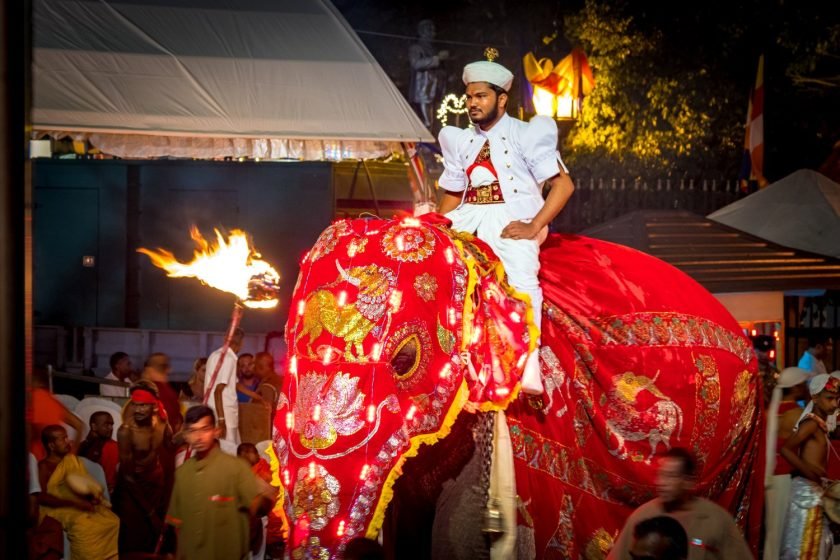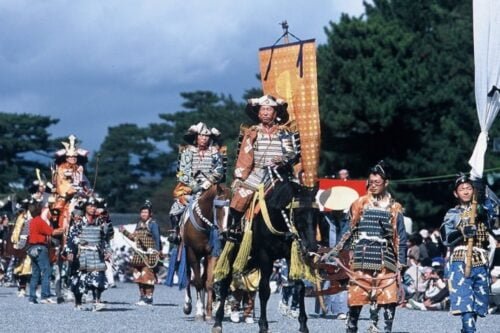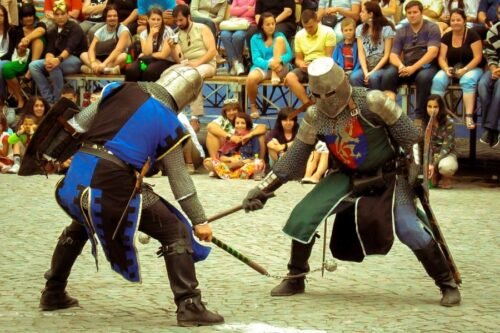Kandy Esala Perahera is an event during which sinhalese people show their appreciation for the Lord Buddha. The central element of the festivity is the Sacret Tooth – an alleged piece of the Buddha’s earthly remains.
They start having this event more than 1000 years ago. During all these years many traditions were created and many others were forgotten. But because this event is so old, it manages, at least for 10 days a year, to keep alive the most important of them.
1. Festival background
Esala refers to the month of Esala, which is the eight month of the Buddhist calendar (which usually fall in July or August in the Gregorian calendar). Perahera means procession. So Esala Perahera means the procession from the month of Esala. The Buddhists have peraheras in each month but the one from the Esala month is special: this is the time of the year when they believe that Lord Buddha was born, had his renunciation and gave his first sermon.
The origins of this festival are believed to have started in the 3rd Century BC. At that time it was called Dalada Perahera and it was a ritual to ask good rainfalls from the gods. However, in the 4th century AD, The Sacred Tooth relic of the Buddha was brought to Sri Lanka. Being a symbolic representation of the living Buddha, the Sacred Tooth relic become the central element of this festival.
In the past the Sacret Tooth relic was joining the Kandy Esala Perahera installed on a special elephant called Maligawa. Today, for security reasons, the relic is left inside the temple. What can be seen on the Maligawa elephant is only a copy of the Sacret Tooth casket.
1.1 Buddha's Tooth Relic
According to Sri Lankan legends, when Buddha died in 543 BC, his body was cremated and his left canine was found in the ashes by one of his disciples. That guy gave the tooth to his king for veneration – the king accepted it and so the relic become part of the subsequent royal heritage. Over time, probably due to the fact that the relic was possessed/protected/honored by kings, people started to believe that whoever posses the tooth had a divine right to rule that land.
The Indian subcontinent was many times threatened with invasions so in order to protect The Sacred Tooth relic their caretakers moved it from one place to another. Finally, in the 17th Century AD, the relic was brought to the city of Kandy where a special temple was built to hold and honor it: The Temple of Tooth.
2. EVENT DETAILS
2.1 Activities program
Although Kandy Esala Perahera is considered to start with the Kumbal Peraheras (Kumbal processions) there are some less important activities that take place before that. Since they are related with this event it is worth mentioning them.
A. Kapsituveema (the ceremony of planting the ‘Kapa’ tree). 5 days before the festival.
In Kandy, very close to the Temple of the Tooth, there are four devales (temples) dedicated to the four protective gods of the island: Natha, Vishnu, Kataragama and Pattini. A few days before the new moon in Esala month, the chiefs of these devales go in search of a young but fruitless jackfruit tree. Once they find it they clean the ground around it, fumigate with the smoke of burning resins and wash it with specially prepared sandalwood water. After cleaning it, they place at the foot of the tree flowers, betel leaves and lighted lamps. After that, they implore the deity who might lived in that tree to leave it.
Next, the tree is cut in four pieces, one for each of the four devales. Each piece is carried in a specific procession and planted inside its corresponding devale. In the past the planting place was outside the devale perimeter but now it is made inside, on a special elevated ground specially build for that. That place is called kap-situweema [ *, *, *].
B. Devale Peraheras (Devale Processions). 5 consecutive days before the festival.
For the next four evenings after Kapsituweema, each devale have a small perahera around the place where the jack-fruit piece was planted. The ceremonies are made of musicians (especially drummers), flags bearers, spear-men and holders of “Ranayudha” – the sacred insignia of the god.
On the fifth evening, the peraheras move outside devales. This time god insignia are carried on the back of an elephant on a dome like structure called “Ranhilige”.
C. Kumbal Peraheras (Kumbal Processions). Day 1- 5.
This is the beginning of the main part of Kandy Esala Perahera. It comprises in five peraheras assembled into one in this order:
0. Openers – whipcrackers and firejuglers that clear the way.
1. Dalada Maligawa Perahera – the parade of the Temple of the Tooth which carries the Sacred Tooth Relic. It’s specific color is white.
2. Natha Dewale Perahera. It’s specific color is light yellow.
3. Vishnu Dewale Perahera. It’s specific color is blue.
4. Kataragama Dewale Perahera. It’s specific color is red.
5. Pattini Dewale Perahera. It’s specific color is dark yellow.
Each day, somewhere around 5 or 6 PM, the four Devale Peraheras start heading to the Dalada Maligawa (Temple of the Tooth) where the Dalada Perahera is waiting for them. At a precise time the assembled perahera starts following a predefined route which is marked by street signs. The route is different each day so you can check it here or trying a Google search on Kandy Esala Perahera Route Map.
The starting time of the assembled perahera is not the same each day because it is calculated according to some astrological observations and calculations. Anyway, most of the times it’s somewhere 7 and 8 PM. If you want more accurate and up-to-date information check the local newspapers and festival schedule posters you can find in the restaurants close to Temple of the Tooth.
Also, the main perahera moments are announces by four cannon shots, as follows:
- First: start of Devale Peraheras;
- Second: the copy of the Sacred Tooth Relic is placed on the Maligawa elephant;
- Third: start of the assembled Perahera;
- Four: end of assembled Perahera.
D. Randoli Perahera (Randoli Processions). Day 6-9.
Randoli peraheras are enriched and expanded versions of the Kumbal peraheras. Its main additions are:
- palanquins (randoli) of the four devales. Each of them are colored in devales specific color and are placed at the end of each devale perahera;
- a greater number of dancers involved in more diverse and elaborate dances like Kandyan, Coconut Flower, Uddekki, Raban, Nayyady, Sword Drill Prashasthi, Chamara, Lee Kelly, Thalam, Hawady, Pantheru and more.
- juglers and of course, more and more beautifully decorated elephants.
As I’ve seen on a local TV channel, during that delay the peraheras are assembled and ready to go but they are performing inside the courtyard of Temple of the Tooth in a perimeter where only some officials and local TV stations are allowed. So its like they perform first for the officials and only after that for the regular public.
E. Maha Randoli Perahera (Grand Randoli Procession). Day 10.
It has the same characteristics as the previous Randoli peraheras. Both the festivities and the crown are at their greatest extent.
F. Diya Kepeema (the water cutting ceremony). Day 10.
2.2 Event Access/Tickets info
2.3 Tips and Tricks
- if you want to get a good viewing spot on the streets to and find it no later than 3 or 4 PM;
- buy a plastic foil and mark your teritory;
- for taking good pictures choose a place with good light (near a street light pole);
- Find a place at the first half of the perahera route. On the second half the dancers are pretty tired and for this reason they often loose their syncronisation.
maps of importants places (including toilets) etc.
Booking seats to see the processions
It is recommended to arrive at your watching spot by 5 p.m. and be well equipped with food and water and any other requirements for about 3-5 hours [ref]. Once the procession begins, you will have great difficulties look around for refreshments and anyway, by doing so, most probably you will loose you seat. The duration of the procession increases with each passing day, the last day being the longest.
2.4 Organiser
Temple of Tooth, Kandy, Sri Lanka.
Address: Sri Dalada Veediya, Kandy 20000, Sri Lanka (Gmaps location)
Website: http://sridaladamaligawa.lk
Event Oficial Website: Click here
Phone: +94 812 234 226, +94 812 205 839
E-mail: info@sridaladamaligawa.lk
3. NEARBY ATTRACTIONS
- attraction name + link to the corresponding map from my attraction map/gmaps, a short description (sorting by distance?);
- etc.;
- see more on Wikitravel
4. HOW TO GET TO KANDY?
4.1 Visa requirements
All visitors to Sri Lanka must hold a passport valid for 6 months. They are also required to get an entrance Visa prior to arrival or on arrival. If you want to know more about the visa requirements in your case or even to get one please fill the form bellow and follow the instructions.
Besides valid passport and Visa, people coming from Afghanistan, Iran, Iraq, Nigeria, Pakistan, Somalia and Syria must hold return or onward tickets.
4.2 Health and safety
tbd
Short Drugstores, hospital and police list. At least contact data for at least one of them.
4.3 Money
4.4 Special conditions
like clothing, weather, alcohol, behavior, taking pictures;
During Esala Perahera festival all the wine stores (places where you can buy alcohol) are closed.
4.5 Spoken languages
4.6 Transportation
airplane/bus/train/ferry/taxi;
Rent a car, motorbike, scooter or bicycle.
4.7 Mobile communication
4.8 Where to sleep
General info.
Free/Budget options (prices and examples), average options (prices and examples) etc.
4.9 What to eat and drink
(Chicken) biryani. Description. Ingredients. Picture. Regular rice.
Kottu. fff
Egg hopper. fff
Egg rice. fff
Milk Tea. fff
Woodapple juice. fff
King Coconut. fff
Beer. fff
Arrack. fff
Short supermarket list
4.10 Where to buy souvenirs
Best places to buy souvenirs.
4.11 Organised tourism
5. MISSING INFO
To be defined.
6. CONTRIBUTORS LIST
No contributors yet.







